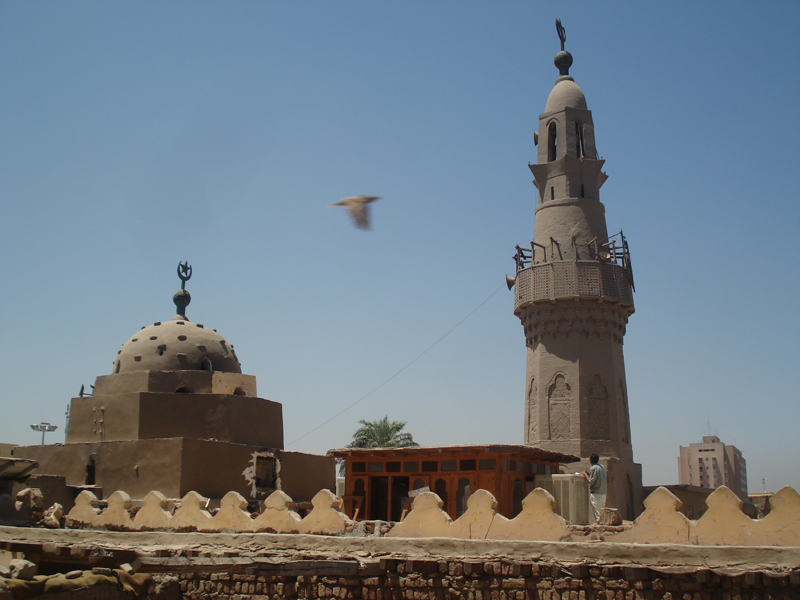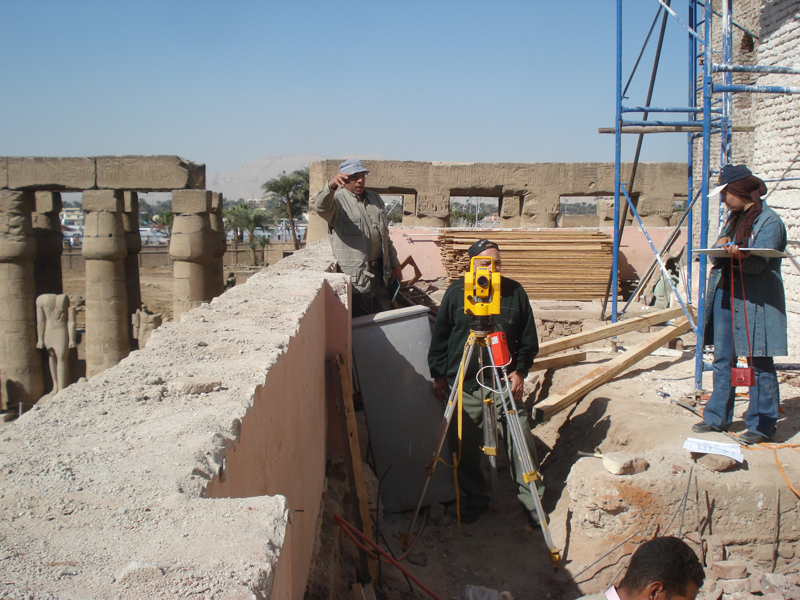- Era13th Century AD
- Project DirectorNairy Hampikian
- LocationLuxor/Thebes
- AffiliationAmerican Research Center in Egypt (ARCE)
- Project SponsorUSAID
- Project Dates2007-2008
- Project ImplementerARCE
In 2007, catastrophe struck the mosque of Abu’l-Hajjaj. Faulty wires in the mosque’s dome sparked an electrical fire that heavily damaged the building. The Egyptian Supreme Council of Antiquities officially listed the mosque as an Islamic monument and brought it under their management and care to begin repair and conservation work. In parallel with this project, the American Research Center in Egypt – with funding made available by the U.S. Agency for International Development – commissioned a documentation survey to record the architectural history and development of the building. This was the first-ever documentation of its kind for this distinctive site and provides a sharper picture of the enigmatic mosque’s architectural past.
Set nearly 30 feet (9 meters) above ground level at Luxor Temple atop the northeastern corner of Ramses II’s court and wall, the mosque of Abu’l-Hajjaj is a visual oddity. The post-Pharaonic history and uses of Luxor temple help explain how a medieval mosque landed atop one of the country’s most recognizable ancient Egyptian monuments. In the fourth century, the temple was modified to function as a military base for the Roman army. It operated as an active fortress under the Romans until well into the second half of the sixth century. Numerous churches were built within the temple’s walls, including one inside the great court of Ramses II in the same location where the mosque of Abu’l-Hajjaj was constructed later.
Due to scarce early documentation, it is unclear what changes or activities the temple experienced following the end of Roman rule in Egypt and the advent of Muslim rule in the seventh century. However, it appears in later 19th-century drawings and photographs that the temple had been buried partly under the accumulated debris of continuous habitation, with a mosque visible amid the houses filling the temple’s first court.
The mosque itself was built in honor of Sheikh Yusuf Abu’l-Hajjaj. He was a Muslim scholar and teacher who migrated from Baghdad to Luxor in his youth and quickly gained a reputation for his wisdom and piety. Probably, he lived within the site of the partially buried temple and conducted his religious teaching there. By the time he died in 1244, Abu’l-Hajjaj was well over 90 years old and had amassed a large and loyal following in Luxor. His body was placed in a mausoleum located on the roof of the ancient church, which by this point was buried below ground level. This site is where the early structure of the current mosque was erected a decade later by Abu’l-Hajjaj’s son.
Abu’l-Hajjaj may have been buried on the site of an already existing mosque, as the older of the two remaining minarets dates to the Fatimid period, some 150 years before the saint lived in Luxor. The present mosque was constructed in the 1820s and the second minaret in 1851-52. Abu’l-Hajjaj’s mosque is the only enduring part of the ancient town of Luxor that survived the archaeological clearance undertaken to expose the temple from the 1880s to the 1950s.
Two experienced heritage architects, Nairy Hampikian and May al-Ibrashy, led ARCE’s documentation and surveying team. They worked onsite for a year during the extensive reconstruction and repairs following the 2007 fire. Conducting the documentation project in tandem with construction work offered a singular opportunity to examine the building fabric of the mosque and provided a great deal of information about its history and construction, as well as how it was integrated within the ancient structure of Luxor Temple.
During restoration, conservators removed cement and plaster covering the interior and exterior mosque walls and the minaret, revealing original hieroglyphic reliefs and inscriptions, as well as medieval texts. Hampikian and al-Ibrashy carefully photographed and recorded all of these markings. The floor of the mosque was dug up, revealing for the first time hieroglyphs on the temple blocks that support the mosque. The team also discovered and documented a medieval-era well shaft under the ground near the mosque’s second minaret, in addition to many other archaeological remains.
The documentation team noted changes made to the mosque during this last restoration phase, thus preserving vital information for any future conservation or repair work. These records are especially important given the mosque’s significance in the life of the local community, which uses it for prayer services and religious events such as the annual mawlid festival that culminates 15 days before Ramadan and attracts large numbers of pilgrims from all over Egypt. During this festival, a procession of boats parades around the temple, carried by the descendants of Abu’l-Hajjaj. The boats symbolize his journey to Egypt. A modern interpretation of this festival draws parallels between the ancient festival of Opet, when the sacred images of Amun, Mut and Khonsu were carried in boats between Karnak and Luxor temples. While the mosque is still used on a daily basis by the community of Luxor, it is always open to visitors looking to experience Egyptian heritage in a new way.

